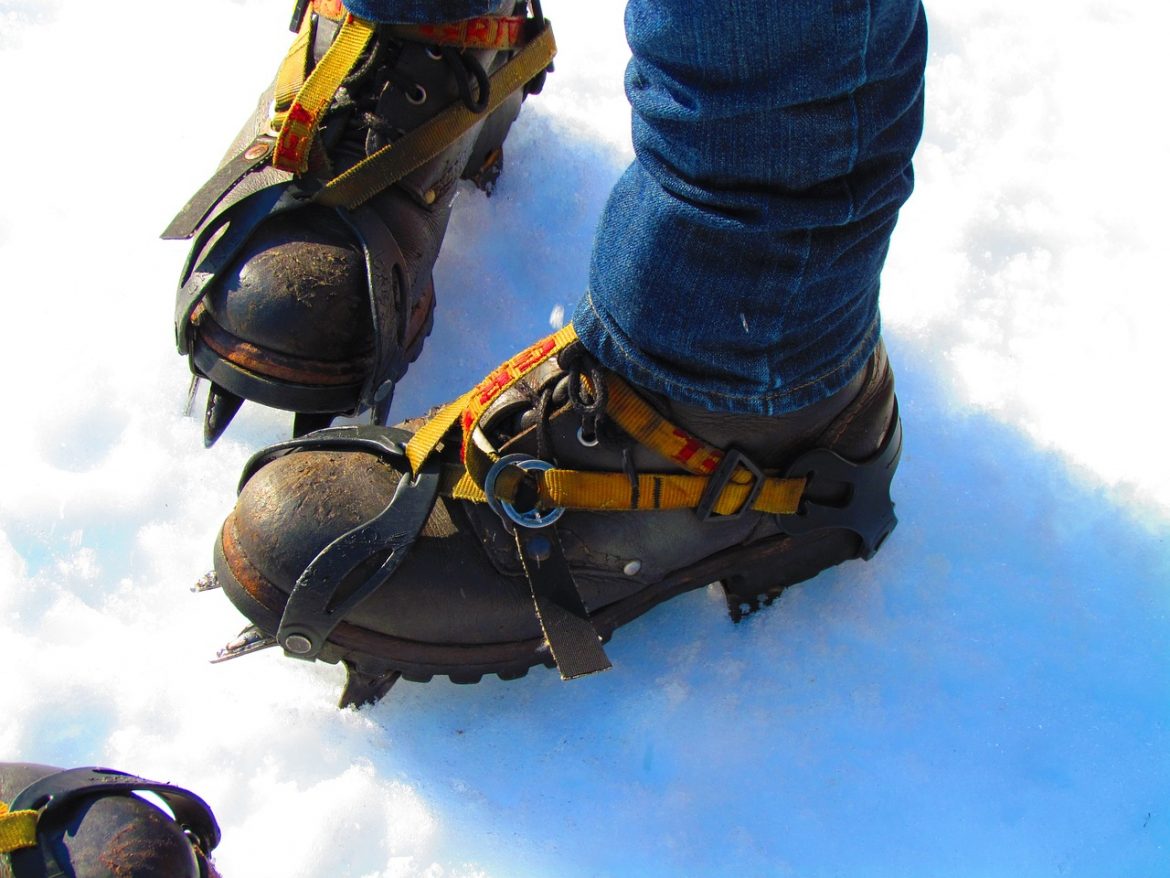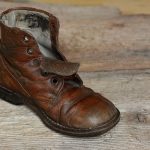Traction cleats. Ice grippers. Four words that might be a bit confusing to you at first. In fact, maybe those words are not known by you at all. Perhaps a friend or colleague has recommended them. Used in the event of bad weather, or in the event that you are going to be climbing up and down hills, these are very valuable tools used to help keep you on your feet in a safe, healthy manner. Today, we are going to be taking a look into the world of ice grippers and traction cleats. We will be answering the why, how, and where, and on top of that, our buying guide will also include some of the best and most popular options to outfit yourself properly for safety. So, let’s get to it without any further adieu!
Top Ice Grippers and Traction Cleats Comparison Chart
| Product | Material | No. of Teeth | Price | Where to Buy? |
|---|---|---|---|---|
| 1. Auhike Version 19 Tear Resistant Traction Cleats | Plastic, Stainless steel spike | 19 | $$ | Check Price On Amazon |
| 2. Limm Crampons Ice Traction Cleats | Rubber, Steel metal studs | 10 | $ | Check Price On Amazon |
| 3. Unigear 18 Spike Traction Cleats | Thermoplastic Elastomer, Stainless steel spike | 18 | $$ | Check Price On Amazon |
| 4. Yaktrax Snow Walk Traction Cleats | Steel coils, Polyelastomer | 0 | $ | Check Price On Amazon |
| 5. Jshanmei Anti Slip Traction Cleats | Thermoplastic Elastomer | 24 | $ | Check Price On Amazon |
| 6. Yaktrax Diamond Grip All-Surface Traction Cleats | Rubber, Steel beads | 5 | $$$ | Check Price On Amazon |
| 7. Odier 24 Teeth Ice Grippers | Elastic silicone straps | 24 | $ | Check Price On Amazon |
Ice Grippers and Traction Cleats Buying Guide
Purpose
There may be some confusion about what the ultimate purpose of a pair of ice grippers or traction cleats are. This is understandable, since some of us live in places where this seems like a small deal. If you are from parts of the world where there is good, warm weather the majority of the time, you may be totally unfamiliar with ice grippers and traction cleats. In essence, they are a piece of machinery that helps you keep your feet firmly planted to the ground. This is done by ensuring you do not slip or fall. If you come from a city where it snows quite often, you might have seen cars that have chains around them to help boost traction. The idea is much the same here. You have your normal shoes and then you add on the ice grippers or traction cleats to them. This is much cheaper than buying a pair of shoes that are specifically made for this sort of thing. As far as the purpose goes, it is twofold. You could use them for going on climbs, particularly if you are a novice and don’t want to spend a lot of money. You also might want them to simply help you navigate in and around town when the weather is less than ideal out. It may sound a little goofy at first, but it will be far from a laughing matter when you are walking on eggshells and crossing your fingers that you don’t fall.
Types of Ice Grippers and Traction Cleats
Despite the idea being generally the same, there are some differing approaches that can be taken with ice grippers and traction cleats. How they are designed can and will have a big say over the direction you are able to go and the ultimate usefulness of them. While all of them are going to be better than going with a slick bottomed shoe, obviously, some will perform better than others in certain situations. In this section, we take a look at which setups are the best and which just do an adequate job at it. The majority of ice grippers that you see out there are going to come in the form of rubber with coil being wrapped around them. What this produces is a decent amount of safety and traction, but it’s also seen as a value choice. To go a step beyond, you would want to pick something that has some spikes to it, rather than the coils, that way you get more traction supplied. Some offerings will take Nylon, which is known for being quite strong, and then attaching it to a plate that has steel ‘studs’ to it. Lastly, there is a variety that are much like tire chains out there, as we discussed above. That type is going to be the least expensive of them all and will supply you with a decent amount of traction. It’s just not going to be the best for things like climbing or hiking. If you plan to go do one of those two things, you might want to spend a bit more and get something that has actual spikes or cleats, that way you can dig into the ground and move along a bit better.
Thinking About Usage
While there is going to be a temptation to go well beyond what you need them for, you should really be thinking about what kind of use you’re truly going to be having for your ice grippers or traction cleats. For example, if you know you just need to go to the mailbox or to the car and back, there you don’t need nearly as aggressive of a pair of traction cleats. You might just be able to go with a pair that’s like the old car-tire method. However, if you are going to be in extreme conditions, then you will need to start thinking about a more hardcore approach, if you will. You will want to go with a model that has more than just chains to it, since you’re going to need all the help you can get to stay planted firmly on the ground.
Durability
Much like figuring out what your usage is going to be, you also need to make sure and factor in the durability of a pair of traction cleats or ice grippers when you think about buying them. Let’s take the case of someone that lives in a place where snow is common but not all that frequent. This is a perfect case to illustrate that you don’t need the most rigid and well made piece of machinery in the world. It would be nice to have, sure, but do you really need it? The answer here is a clear no. You don’t need it because you won’t be putting it to the test all that often since your use is going to be reduced over someone that is seeing that sort of weather all of the time, or at least all of the time during the harsh winter months. With that said, you also have to turn the token over to its other side and make doubly sure they are sturdy enough for you if you’re going to be wearing them a lot. If you hike or climb, or it’s just a big part of the climate you live in for snow and ice to be around a lot, then you’re likely to wear them a whole lot more. It’s painfully obvious that you don’t want to pick something that will tear and rip and cause you to need a replacement, so you should look to go a bit sturdier. You can find tremendous value in both approaches, but you just have to do it!
Don’t Forget Elastics
You might be wondering what on earth elastics has to do with ice grippers and traction cleats, and we don’t blame you. At first glance, it’s hard to see how this has any bearing on what you might be doing. But in truth it really does matter. In order to have the best experience possible, you are going to need something that has some elastic properties to it, particularly in the upper portion of the ‘gadget,’ if you will. What this does is help the mechanism to stay in place and to do so comfortably as well. If it were just chain, it would be quite painful and could cut off a lot of circulation and cause great discomfort to your feet. On top of that, having something elastic available also makes it much easier for you to make adjustments to the shoes. If you are unable to make those tiny changes, you will never truly be comfortable. On top of that, it would be like rocket science to try and get them on in the first place. So, it should now go without saying that you need a decent, stretchy system to help aid you in this endeavor!
Spike Placement
Depending upon where the spikes are placed, if they have them at all, will have a big impact on the usefulness of your new shoes. If you are looking to just go for a walk, or maybe even want to stay in shape during those harsh winter months with a run, then you will still want to possibly have spikes, especially if you are in the second category. What you want here is just something that will keep you in touch with the ground without going overboard. Going overboard would be adding extra spikes that end up making you more heavy. On top of that, they’d be more expensive. Now, when it comes to hiking and climbing, you’d want to go up a notch or two. You want setups that have spikes on the front, sides, and possibly even the back of the cleats. Of course, you’re going to want them on the bottom, but that should go without saying. The reasoning behind this is the same as with any type of cleat. The more areas where it makes contact with the ground, the more chance you have at staying on your feet. You don’t see football or soccer cleats with any one large area missing spikes, so you don’t want to see large swathes of land left out here, either.
Comfort
One other biggie that you need to have a think about is the comfort at which your ice grippers or traction cleats will provide you with. If you’re not going to be comfortable wearing them, you’re likely to end up ditching them and leaving them sitting in the corner so that they can collect dust. That’s not ideal, and you’ll be wasting money, basically. In today’s era, it’s a lot harder to determine how comfy something is. Nobody wants to go in person to try things on, but at least with these sorts of products you do have an excuse. There isn’t going to be a plethora of places carrying such items, so you get a slight pass on that. At any rate, you need to take a few things in mind. One of them will be research and reviews. If everyone is complaining about a pair of grippers or traction cleats hurting, then you are not likely to find a ton of comfort. It’s just not going to happen. Everyone’s foot is slightly different and you may like one thing over another, but this is hard to overcome. The best way to see if you can tolerate them as being comfy enough or not is to try them on immediately when they arrive. Maybe there is no snow out, but you can still check and see if you’re going to be able to live with it. If you can’t, it’s best to find out right away and then make a change. In some instances, you’ll just have to get used to the way they feel. That takes some time and effort, but in the end you’ll be thankful for exhibiting a little bit of patience when they feel good and keep you on the ground safely.
Fit
When it comes to comfort, a very large aspect of that is going to depend upon how well the grippers or cleats fit to you. If they are not a good fit, they will not be able to slip on your shoes, thus rendering them ineffective. Most commonly, you will find ice grippers and traction cleats to come in a range of sizes. For example, you might see that a pair has a large that runs between sizes 9 and 13. If you are right on the edge, you will need to be very careful on what you pick. It may leave too much room or not enough, so you’ll need to read reviews and try your best to judge what others are saying so as to not make a mistake. Looking over sizing charts is absolutely critical for you here. Failure to do so could mean that you end up with a size that is not truly up to your standards. If the product is coming from another country, or is manufactured there, it may be slightly different with size. One of the quickest ways to being uncomfortable is having the wrong size, so this is not something you should be rushing over and definitely not something you should look past, as trivial as it may seem.
Price
One of the things we pride ourselves on here is helping you find good deals that won’t kill your budget. We’ve all heard the phrase “you get what you pay for.” We’ve probably all heard it a million times, especially if you are close to older folks. That’s very much true, but that does not mean that you have to pay a fortune and a half for a pair of ice grippers or traction cleats. To the contrary, you can find some really good deals out there. Most of the items on our list below are going to come in at this low price range, so you will not have a ton of worrying to do about the budget. It’s more about ensuring you are buying the right kind of item more than anything else! Lastly, you should think about how much you are saving in relation to buying a whole new pair of shoes. Sometimes, you’ll find shoes out there that are made with ice and snow in mind. These types of shoes, though, can be very expensive, and when it’s not snowing or icy out, they have no use to you. You’d look extremely foolish to go out wearing ice boots in the summer, after all. So, you really are getting an extreme amount of value when you buy an item that attaches to the shoes, such as these on the list are. There’s no additional cost and you can take them off at anytime, giving you a lot of freedom of choice!
The Top Seven Ice Grippers and Traction Cleats of 2019 Reviews
-
Auhike Version 19 Tear Resistant Traction Cleats
It’s pretty easy to see why these are just so highly rated. To kick it off, they are resistant to tearing, which is going to be a major plus since you’ll not have any issues worrying with that. They do this through a gasket that has been put through rigorous testing. Made from elastic steel that can tolerate up to -70F temperatures, they can bend yet refrain from breaking. Best yet is the fact that they are a good fit for all kinds of footwear, ranging from shoes to hiking boots and even more. With an 18 month guarantee and good customer service, they are put over the top and further help to drive your confidence as a consumer, making it much easier to go all in and give them a try. They’ve also been shown to be super easy to take on and off, meaning it’s easy for kids to use, too!
Pros:
- Easy to put on and take off
- Very strong yet flexible
- Great customer service
-
Limm Crampons Ice Traction Cleats
If you’re looking for something low priced and quick to get on and off, then this is a good choice to take a glance at. These traction cleats easily slip beneath the feet in seconds, utilizing a sort of lock method to lock them in nicely. When they are not in use, they roll up into a ball almost, making them easy to shove into a pocket or small bag. Because of that, they are ideal for all sorts of various climates as you traverse around more professional settings. Despite the way they might appear, they have protection from slips all over them, using ten metal studs to keep you firmly on your feet. These are not going to be able to get you to the top of Mt. Everest, but if you just need to get around in the city and want to do it safely, this is the way to go. Just be aware that they are a bit loud, so that might play a role, albeit a small one in your decision making.
Pros:
- Great price
- Extremely fast on and off
- Easy to lug around when not using
Cons:
- Makes a lot of noise
-
Unigear 18 Spike Traction Cleats
Unigear is going to cost more than the others we have seen thus far, but it’s only marginally going to be the case. The reason they come in at this higher cost is due to the fact that they have engineered these traction cleats to be lighter than most. You might think that that’s a bad thing, but through the use of a strong thermoplastic, they are just as strong- if not stronger- than most of the others on the market at the moment. This helps them stretch, too, and helps them resist abrasions that might take down inferior models. With 18 spikes on each foot, 12 of which are in the front and six that are in the heel, you are able to have plenty of protection going up and downhill. Coming with a 60 day and 100% money back guarantee, you’re also armed with a bit more confidence than most out there.
Pros:
- Money back guarantee
- Stronger yet lighter and more flexible
- Easy up and downhills
-
Yaktrax Snow Walk Traction Cleats
If you just need to get to the mailbox or outside quickly in the winter when it’s far from the best of conditions and you want to pay a good, low price, then this is yet another fine option to choose from. These traction cleats from Yaktrax are super simple to get on and off, as they are lightweight. Yet, they are made out of abrasion resistant steel coils that are reinforced with zinc to ensure rust does not take over. That’s a bit of a looked over risk with any steel or metal product, so that’s a nice added touch they have been able to bring to the table. With all directions being emphasized, these non-spiked cleats are still going to do a good job at keeping you upright and on the move. With a highly elastic band around them and a pull tab in the heel, they can be used by consumers of all ages and sizes.
Pros:
- Super efficient on and off
- Reinforced steel
- Great, low price
-
Jshanmei Anti Slip Traction Cleats
Coming in at number five is another choice that will not leave your wallet empty. These traction cleats are one of the slip on variety, allowing you to stretch them onto your feet with little to no problems at all. Because of this, they are flexible and are not going to be ultra clunky like some of the others you’ll find. They’ll also be much easier to carry around on days when you need to take them off, which is a big bonus. They are tested to remain working as usual with temps as low as -45 degrees and have full coverage on the entire soles where it matters. There is only a hole in the middle of them thought it’s going to be of any consequence. These will not be the best if you are traversing a mountain or going on some extraordinary mission, but they will do you well when you get outside. Lastly, the durability is worth noting, as they do a good job of lasting despite being relatively low priced.
Pros:
- One of the lowest priced models out there
- Tested to work at less than ideal temps
- Flexible and easy to take off and on
-
Yaktrax Diamond Grip All-Surface Traction Cleats
If you would like to take a pretty large step up, then look no further. These ‘Diamond’ traction cleats from Yaktrax come in at the highest price we have seen so far, but that’s not without a reason. These are very easy to fit around your feet, as you would expect. The thing that makes them stand out from the others we’ve seen is the use of steel alloy around aircraft cable. With that as well as hundreds of tiny edges that go in various directions, you get lots and lots of grip to help you traverse through all sorts of awful weather conditions. Because of their swiveling bead design, they prevent snow and ice from building up in the them, making it all the easier to go into other areas, such as rocks and concrete. It’s the little things, and they add up to help out a ton.
Pros:
- Reinforced like an aircraft
- Swiveling beads prevent annoyance
- Very easy to fit
Cons:
- Highest price on the list
-
Odier 24 Teeth Ice Grippers
If you want more of an actual gripper design and you don’t want to pay down a ton of money, then you will find these to be a nice choice. These from Odier contain 24 ‘cleats’ to them with the majority placed up in the front to help when you descend down hills. Still yet, the back of the foot is not compromised and you’ll still get plenty of coverage there. Another big advantage that they are able to offer is a lot of compatibility, allowing you to use them with all kinds of footwear. That means you don’t have to just use them with boots, which is a relief to some people for sure. They hold up well under low temperatures, too, but they have not been tested as rigorously as some of the others, so if you are in extremely low temps, you may want to exercise some caution. With elastics, these are easy to get on and off, getting you on the ground quickly and efficiently.
Pros:
- Very low price
- 24 spike design to help with various tasks
- Super easy on and off process
Cons:
- Not a ton of testing done, so super low temps are questionable
Conclusion And Final Ice Grippers and Traction Cleats Recommendations
No matter what your use for ice grippers and traction cleats are, they can be a vital part of your day. These pieces of equipment can help you keep safe, and they do so at a very manageable and affordable price as well. Rather than being left out in the cold (pun intended) getting a pair of them can keep you from experiencing a bevy of problems that others regularly face. Whether you’re looking to become an expert climber, or you just want to stay as safe as you can by staying right on the ground, you’ll be aided tremendously by their effect. After our buying guide today, you’ll not only have the information you need to make a good, informed decision, but you will also have real, viable choices to select from. Here’s to you finding the one that is best for you!
FAQ’s About Ice Grippers and Traction Cleats
Are Ice Grippers and Traction Cleats Really Necessary?
The answer to this lies in what you’re looking for. If you live in a cold, wintry environment where you regularly see snow and ice along with cold temperatures, it’s a big ‘YES.’ That is, unless you want to just sit inside and do nothing. If you do plan, however, on leaving the premises and heading outside, then you need to have something to support you and keep you on your feet. Furthermore, if you are going to be hiking or climbing, then you will certainly need to take a look at them as well. You’ll definitely want to have some support before you head out and injure yourself.
Can I Climb Trees In Them?
No, you should not, so please don’t attempt to do this. Despite you possibly having spikes, you are now just magically going to be able to grip into anything. The tree is not going to have the same exact consistency of the ground, so you may slip. On top of that, there is a distinct possibility that you could break your ankle or twist it. Neither of these feel very good, and they would be an awful thing to have happen on a whim as you try to have fun. Plus, you could end up doing some damage to the equipment as well, which is not going to sit very well with you all, we’d imagine.






